How Manchester City have been let down by their squad building
City's success lured them into a period where they stopped building the future. It's now catching up to them
This post shouldn’t be getting written. We’re not supposed to be reacting to Manchester City slipping up in November. We’re better than that because we knew this would happen. In the Kwestthoughts Season Preview, this is what was written about City:
Don’t get caught up by them dropping points early in the season. The only question with City is how many of their final 20 games are they going to win en route to another title?
But it does feel different this time. We’ve already known they are much weaker without Rodri, and the Ballon d’Or winner is out for the year. Losing six of your last seven matches and not picking up a win is not nothing. I do think Pep eventually figures things out and City will be fine, but an eleven point deficit without Rodri may be just too tall a task. So ultimately I relent.
If we were paying attention, the first sign that something might be off at City occurred this summer when the club re-signed Ilkay Gundogan1. Bringing back the 33 year old, even on a free transfer, was an uncharacteristic move for what had been a very well run club.
Gundogan joined City when he was 25 years old. He made 287 appearances with the club over the next seven years and served as captain for their treble winning side in 2023 after which his contract expired. Pep Guardiola made no secret that he wanted to bring back Gundogan but City were not willing to offer the 32 year old a new contract.
From a business point of view this was the right decision. Gundogan’s skills were deteriorating in the back end of his career and City felt the production he’d be able to offer them going forward wasn’t going to justify the wages he was asking for. It was a difficult decision but the kind that well run clubs make2.
That a year later City were ready to bring back a now 33 year old Gundogan is a acknowledgement not only that the club failed to replace him, but that they didn’t have anything in the works either. What was once a very well run club, wasn’t as well run anymore.
There is no singular reason why City are sputtering this year. Several different factors converged at once to give us this poor form. We’ll be focusing on just one of those - City’s lack of long term squad building - as that issue lies at the heart of both why Rodri has become so irreplaceable for them as well as their change in style of play.
The foundation for the City team that clinched six Premier League titles in seven years did not begin with the arrival of Pep Guardiola. It was a poorly kept secret that Guardiola was going to end up in the blue half of Manchester, and City certainly acted like they were preparing for Pep’s arrival.
During the summer of 2015-16 City began the first wave of signings that would play a key part in the Pep era, notably Kevin de Bruyne, who is now captain of the club.
This is a pretty successful window. Sterling would ultimately score 131 goals and win 10 trophies in his seven seasons at the club. City wisely knew to move him on when he was entering his age 27 season, as Sterling had already been a top flight player for 10 years. That they managed to get £47.5 million for him at 27 years old is a sensational bit of business and makes him one of the best signings the Premier League has ever seen3.
In the summer of 2016 Guardiola arrived and so to did more signings.
The famous error is Claudio Bravo but this is another very strong window. Leroy Sane had back to back seasons of 10 goals and 10+ assists and was moved on for a profit.
Three teenagers in the window represent the duality of what City were trying to do. Players like Gundogan, Sane, and Stones bolster the team now and for the next few years. Moreno, Zinchenko, and Gabriel Jesus were younger players who could take a few years to settle and then hopefully push people out of the XI.
Moreno never went anywhere. Zinchenko never became a full time starter but played a part in four title winning teams and was sold for £30m. Jesus was a January signing who was supposed to really push Sergio Aguero - who wasn’t really a Pep player - out the door. That never really happened partially because of Jesus but mostly because Aguero just kept scoring. Jesus played his part in four title winners had two seasons with over 20 goals in all competitions and was also flipped for a profit. All in all a pretty successful window.
Then came the summer of 2017 when City moved to correct some mistakes and put the finish the final steps of building this squad.
City would finish with 100 points that season as they won their first league title under Guardiola. Over the course of three years City signed key players to add to a squad that already had guys like Vincent Kompany, David Silva, and Fernandinho to form a powerhouse. It didn’t come cheap. City spent £570.25 million over those three seasons and they allegedly broke a ton of rules in doing so4.
What stands out here is how successful City’s recruitment was over a three year period. While the money and alleged cheating can’t be ignored, having tons of money and (allegedly) breaking the rules doesn’t offer any guarantee that you’re going to actually spend the money wisely and sign good players.
The 19 players signed over those three windows averaged 122.5 Premier League appearances for the club. City ultimately paid £240,000 per Premier League appearance.
Not only did City win 100 points but the squad’s average age of 26.0 is the youngest of any Premier League winner over the last seven seasons. They were good and they had longevity, which meant City no longer needed to be throwing tons of money at their squad every year. They could change their strategy to simply buying luxury players, doing a like for like replacement if a player left, or signing someone for the future.
They promptly got going with that strategy. Right after winning 100 points City spent £60m on 27 year old Riyad Mahrez. Did they need him? Of course not. Why’d they do it? Because they could.
A year later Fernandinho was coming to towards the end of his time so £62.8m was spent on Rodri to help push him out the door. Joao Cancelo came in to replace Danilo who had never really gotten going. A year later center back cover arrived with Nathan Ake and Ruben Dias.
We also saw the Pep attempt to shake up the attack for the first time. Leroy Sane shipped out and David Silva left. To replace them the highly coveted 21 year old Ferran Torres came in along with increased minutes for academy graduate Phil Foden.
If the plan was for Torres and Foden to push into the starting XI it didn’t quite work. Foden became a mainstay with City but Torres only lasted 18 months at the Ethiad. Don’t worry they still sold him for about double what they paid for him. Plus earlier that summer City also threw down £100m for Jack Grealish, another player whom they didn’t actually need but why the hell not?
All in all here’s the full list of first team signings City made from 2018 through last season.
Overall this is really good. There are some big successes in here. There are a few ‘why the hell not’s” in there but hey, they were in a position where they could make some why the hell not signings. But compared to their windows from 2015-2018 there are a lot more misses.
The average fee price City paid rose from £30.01m to £40.32 million. The average appearances will obviously be lower because the new players haven’t had the chance to make as many, but even just looking at the first four years on this list, the average number of Premier League appearances per signing dropped to 80.2. Overall City are paying £680,000 per appearance though this number will get lower.
It was inevitable that City would not be able to sustain their hit rate from those first three years, but it’s not just the amount of whiffs they had, it’s where those whiffs came. Look over the list again and you may notice there’s a lack of central midfielders. City nailed it with Rodri but didn’t sign another player in that position for another three years.
At the time it was fine as they had Rodri and Gundogan holding down the fort, but if you’re not bringing in reinforcements in the meantime, you're going to run into trouble if you don’t nail the next one you sign. That’s exactly what happened.
City swung and missed badly on Kalvin Phillips. That forced them to scamper around trying to try find midfield cover and landing on a 29 year old Matteo Kovacic. There was no doubt Kovacic had the ability to slot into this City team, but at 29 years old with a ton of miles on his legs from Inter, Real Madrid, and Chelsea, his mobility had taken a hit. His body is far more prone to break down. If Rodri gets hurt and your backups are in your 30s, there’s a good chance one of them will get hurt too!
Herein lies City’s biggest issue. Whereas De Bruyne, Bernardo Silva, Sterling, Sane were able to immediately push themselves right into the starting XI, their recent signings have not been able to do the same. No one was ever going to be a like for like replacement for Rodri but no one has been able to even come close. Players that City hoped would eventually push the old guard out the door weren’t able to do so with one notable exception.
Erling Haaland.
Early iterrations of Pep’s City had Sterling and Sane playing on their “natural” sides as classic touchline wingers with David Silva and Kevin de Bruyne playing as “free eights” and Aguero in the middle. The arrival of Mahrez saw Pep swap his wingers back to their “off” wings that we commonly see today, with Sterling often playing as almost a second forward from the left similar to how he was used for England.
Between Sterling, Sane, Mahrez, De Bruyne, Silva/Foden, Bernardo Silva, and to an extent Gabriel Jesus, Guardiola’s attack was built entirely out of attacking midfielders who could play anywhere across the front three. When Aguero was out, Pep often deployed a false-9 system with four different players all interchanging and playing different roles across the front four throughout the match. In 2021-22 City scored 96 goals in the Premier League with no one scoring more than 15. Without that static striker, City’s fluidity made them very unpredictable as they had so many different ways to hurt you.
Then came Haaland, a static striker who doesn’t contribute much outside the box. For years Pep had a reputation for demanding that ‘just scoring goals’ isn’t enough from a striker. He needs to contribute in all phases of the game. Suddenly now he had a striker that didn’t do anything but score goals.
Early on that wasn’t a problem because Haaland scored a ton of goals. In his first season Haaland scored 52 goals in 53 appearances in all competitions as City won the treble.
Now, what do you do when you when your core of attacking midfielders are starting to age out, the younger players you previously signed in that mold never broke through, and you have a static striker who scored 50 goals in his first campaign?
You lean into that striker.
Over the past three years City have moved more and more from this multi-faceted attack to an attack build around feeding the ball to Haaland. In Haaland’s first season the striker took 24.3 percent of City’s shots per game. Last season it was 22 percent. This season that number has jumped up to 26 percent. Over the first 12 games of the season Haaland had taken 61 shots in the league, no other City player had more than 20. No surprise he’s scored 54 percent of their goals.
When City originally signed Haaland they also brought in Julian Alverez, a striker who could also play as an attacking midfielder as a wide forward. Alvarez offered City some flexibility, a change of pace to Haaland, but after two years he left because he wants to be a striker.
As City have lost or phased out these duel threat attacking midfielders they’ve been replaced by players like Jeremy Doku and Savio, two dribbly bois who are much more traditional wingers. That’s not bad per say, just different.
Doku and Savio are elite dribblers but they’re struggling to turn that into anything other than trying to get the ball to Haaland. Whereas City used to have a fluid attack filled with players who can interchange and hurt you in various different ways, they’re now very static. A center forward who doesn’t create chances for other flanked by wingers who’s primary threat is creating chances for the striker. It’s much more predictable.
Don’t get me wrong. City’s attack is still very good. They lead the league in both shots and xG. Their last five games in all competitions they’ve averaged 1.84 NPxG per game. They may be more static and predictable, but these are still really freakin good players.
Now City find themselves in this situation where if Haaland goes through a cold patch they’re in trouble. This sole dependency on Haaland is threatening to bring down their dynasty.
City are where they are due to their own failures even when it didn’t look like they were failing. They hit on an absurdly high rate of their signings to build a juggernaut. That put them in a position where they could make luxury depth signings without having to worry about whether they’ll work out or not.
In the meantime they neglected a key area of the pitch in central midfield. They let some big time players from their academy go while the young attacking signings they brought in failed to break in and push players out of the starting XI. With fewer of those duel threat attacking midfielders around and the breakout of a young striker they figured their best bet was to try and replicate that form as often as possible.
City failed to replenish their squad in key areas that’s lead to a bit of mismatched. Not all the players fit together the way they used to. Their depth in certain areas is alarmingly thin.
When you’re short on depth and pick up an injury in the wrong place… it can all unravel really quickly.
In theory you could go back to signing the 29 year old Matteo Kovacic but we’re starting here
Even if City got it wrong, you make that decision a bunch of times you’re gonna come out right more often than wrong
Just imagine spending £44m on a player having them for seven years where they make over 300 appearances, score over 100 goals, win 10 trophies, and then you recoup all the money you spent on them? That’s as perfect as you could wish for
City’s 115 pending charges cover a time period up until 2018




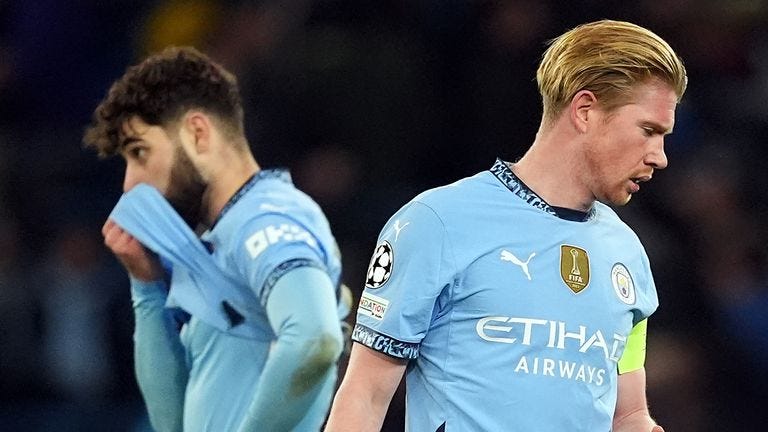
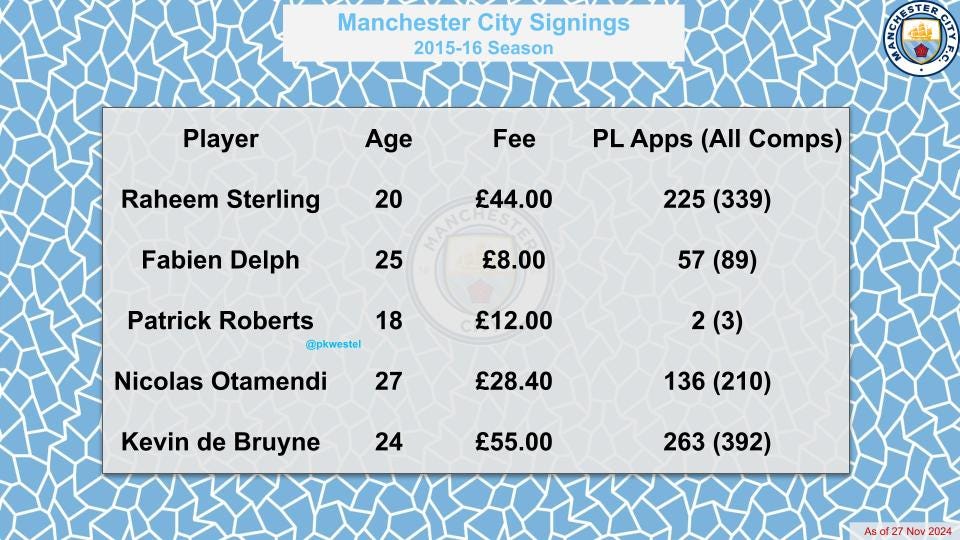
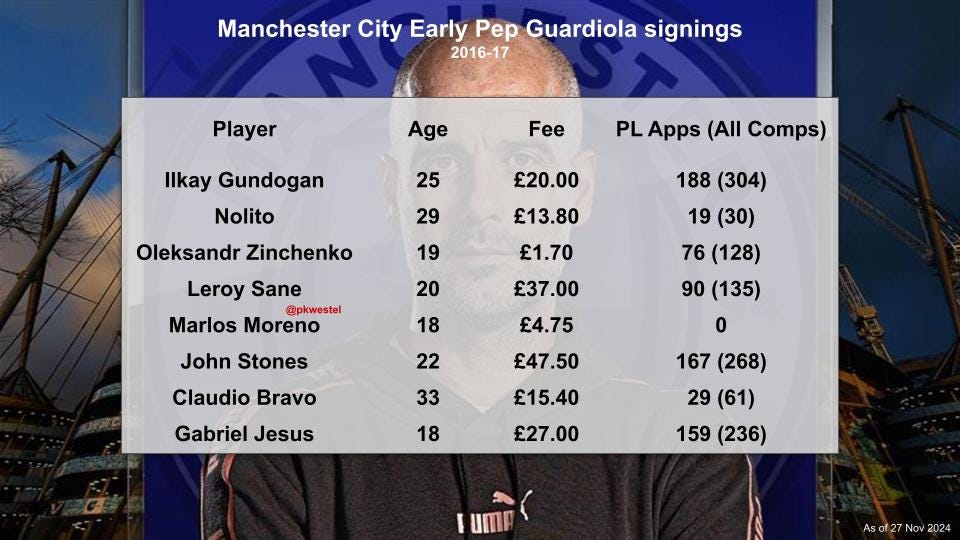
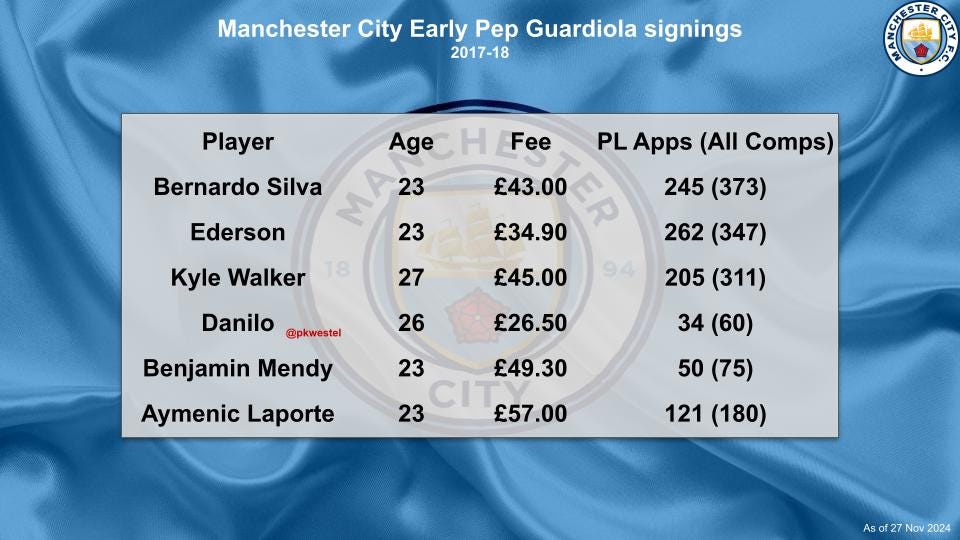
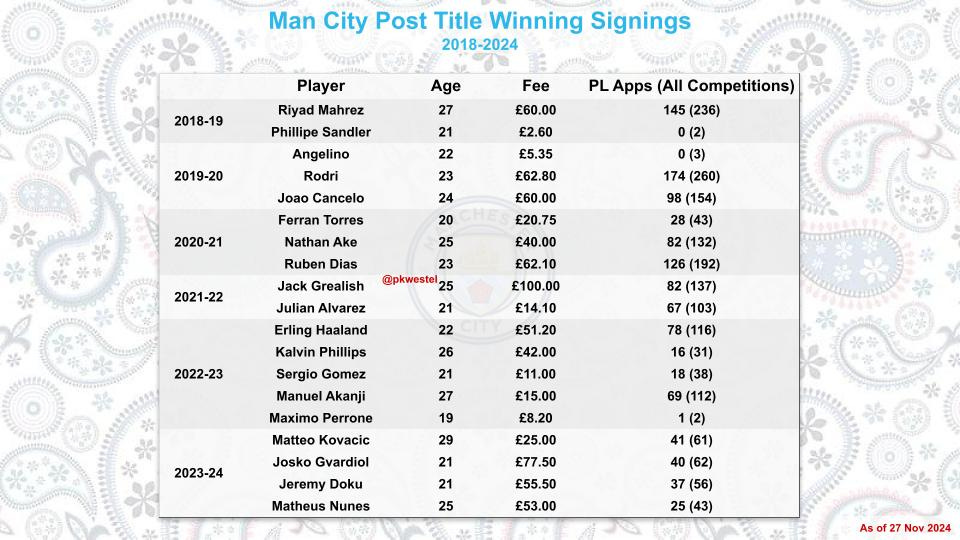
Good article. The recent struggle City has been facing is bringing me nothing but joy
Great text! I also think there is the psychological effect of not winning actually adding up to poor performances that in the beginning of the sequence weren't bad, but just unlucky. Congrats on the piece!